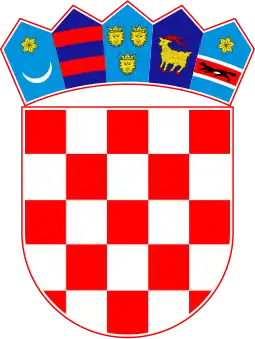
The Croatian interlace or Croatian wattle, known as the pleter or troplet in Croatian, is a type of interlace, most characteristic for its three-ribbon pattern. It is one of the most often used patterns of pre-romanesque Croatian art. It is found on and within churches as well as monasteries built in early medieval Kingdom of Croatia between the 9th and beginning of the 12th century. The ornamental strings were sometimes grouped together with animal and herbal figures.
Most representative examples of inscriptions embellished with the interlace include the Baška tablet, baptismal font of Duke Višeslav of Croatia and the Branimir Inscription. Other notable examples are located near Knin, in Ždrapanj and Žavić by the Bribir settlement, Rižinice near Solin and in Split and Zadar.[1]
Croatia has a civil and military decoration called the Order of the Croatian Interlace.[2]
Pleter Cross
During the 8th century, the Pope assigned Croatia with its own idiosyncratic cross based on Croatian interlace. It is commonly known as The Pleter Cross. The symbol is still very much used and adored in Croatia in the modern day as it represents both Christianity and Croatian Culture.[3]
Gallery
Examples:
 Inscription of duke Branimir
Inscription of duke Branimir Inscription of king Stephen Držislav
Inscription of king Stephen Držislav Font from the 11th century (most likely a depiction of Petar Krešimir IV or Demetrius Zvonimir)
Font from the 11th century (most likely a depiction of Petar Krešimir IV or Demetrius Zvonimir)
 Emblem of the Ustaše, a former fascist and ultranationalist organization, as displayed on the state symbols of the Independent State of Croatia
Emblem of the Ustaše, a former fascist and ultranationalist organization, as displayed on the state symbols of the Independent State of Croatia Croatian interlace bordering the Seal of Armed Chief of General Staff of the Armed Forces of Croatia
Croatian interlace bordering the Seal of Armed Chief of General Staff of the Armed Forces of Croatia
See also
References
- ↑ "PLETER - povijest uklesana u kamenu" (in Croatian). RivaOn.hr - portal Srednjih škola Zadarske županije. HINA Zagreb. 2002-12-03. Archived from the original on 2011-07-15. Retrieved 2010-05-04.
- ↑ Croatian President (2000-11-03). "Pravilnik Reda hrvatskog pletera" (in Croatian). Narodne novine 2000/108. Retrieved 2010-05-31.
- ↑ "Pleter Cross Description". croatiagifts.com. Retrieved August 3, 2021.
External links
